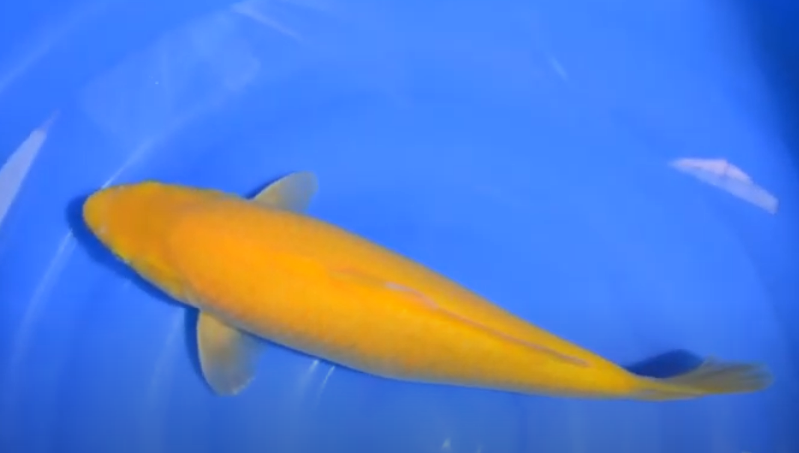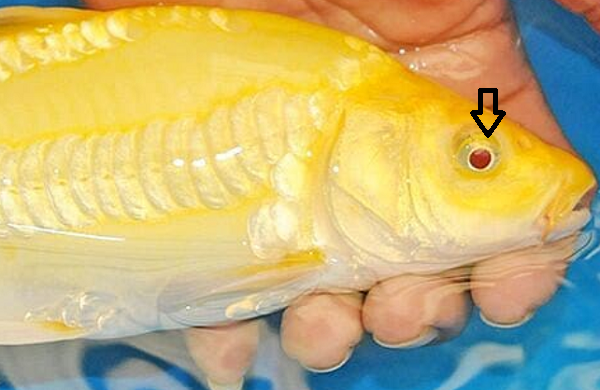
???????? Unveiling the Beauty of the Underrated Kigoi Koi ????
The world of Koi is filled with dazzling colors and intricate patterns, but the Kigoi, often a single, elegant shade of yellow, gets overlooked. Yet, beneath its seemingly simple exterior lies an exquisite charm that awaits discovery.
???????? Understanding the Kigoi’s Uniqueness ????
One Color Wonder: Kigoi belong to the Kawarigoi class, which encompasses non-metallic Koi that don’t fall into other categories like Chagoi or Benigoi. Unlike its metallic cousins, the Kigoi’s beauty lies in its pure, consistent yellow hue, without any markings or blemishes.
A Touch of Sparkle: The ideal Kigoi boasts a vibrant yellow color from head to tail, but some fortunate specimens might even possess sparkling diamond scales, earning them the title of Gin Rin Kigoi.
Rare Gem: For an even rarer find, look for the Akame Kigoi, distinguished by its pink or red eyes. Kloubec Koi Farm is believed to be one of the few breeders of this exceptional variety outside Japan.
???????? From Underdog to Stunning Specimen ????
While young Kigoi might appear plain, they undergo a remarkable transformation within a few years. Like the friendly Chagoi, they readily adapt to hand-feeding and develop a sociable, endearing personality. Their robust appetite fuels their impressive growth, making them a true delight to watch mature.
???????? Choosing the Perfect Kigoi ????
When selecting your Kigoi companion, prioritize a consistent, bright yellow color and avoid fish with orange tinges. For the Akame variety, seek a pair of red eyes, though some may have only one. A broad shoulder area indicates healthy growth potential. Finally, observe the Koi’s swimming behavior to assess its overall health and grace.
???????? Distinguishing Kigoi from Yamabuki Ogon ????
Both yellow, but distinct beauties: differentiating between a Kigoi and a Yamabuki Ogon lies in their skin. The Yamabuki displays a lustrous, iridescent yellow glow, while the Kigoi’s skin has a matte, buttery appearance, like a Brach’s butterscotch candy, with a subtle, non-iridescent shine.
???? The Sun-Kissed Beauty of the Kigoi Koi ????
A Kigoi koi (pronounced “KEE-goy”) is a stunning fish, distinguished by its non-metallic, solid yellow color. It belongs to the Kawarigoi category, which encompasses all koi that don’t fit into specific classifications like Ghost Carp or Butterfly Koi. Other koi in this group include Benigoi (red), Chagoi (brown), and Ochiba (yellow with black markings).
A Long History, Rooted in Nature
The Kigoi is one of the original koi varieties, gaining popularity in the late 1920s. Its ancestry can be traced back to the Magoi carp, a black wild carp native to Japan in the 18th and 19th centuries. As carp transitioned from food fish to cherished pets in the early 19th century, koi keeping flourished, leading to the emergence of many beautiful varieties through mutations and selective breeding. The Kigoi is a prime example of this.
From Red to Radiant Yellow
The Kigoi’s development involved selective breeding of Benigoi koi, a non-metallic, single-colored red variety that had recently been introduced. By carefully choosing lighter-colored Benigoi, breeders gradually reduced the red pigment, culminating in the stunning yellow hue of the Kigoi.

A Touch of Uniqueness: The Akame Kigoi
During the Kigoi’s breeding process in the early 20th century, a chance albino mutation appeared. While such mutations are often excluded from breeding, the breeder in this case recognized its captivating beauty and incorporated it into the Kigoi lineage. This led to the creation of the Akame Kigoi, a breathtaking variety with yellow or orange coloration and distinctive red eyes.
???? The Allure of the Pongoi Kigoi Koi ????
When it comes to koi, few varieties are as mesmerizing as the Pongoi Kigoi. This single-colored koi, boasting a radiant sunshine yellow hue, stands out amongst its more vibrantly patterned counterparts. But what truly sets the Pongoi Kigoi apart is its focus on color perfection and consistency.
Color Consistency: The Hallmark of a Premium Kigoi ????
One of the key factors in determining the quality of a Pongoi Kigoi is the consistency of its color. Ideally, the yellow should be uniform across the entire koi, with no splotches, patches, or breaks in the hue. This unwavering consistency is what makes the Pongoi Kigoi so visually striking, as it creates a sense of elegance and refinement.
The Subtle Charm of Fukurin ✨
Adding another layer of intrigue to the Pongoi Kigoi is the presence of a subtle reticulation pattern called fukurin. This pattern manifests as a slightly darker yellow hue at the base of each scale, gradually fading to a lighter shade towards the tip. While some Kigoi koi exhibit a more pronounced fukurin, others may have a faint hint or even lack it altogether.
A Splash of Sunshine in Your Koi Pond ????
Whether you’re a seasoned koi enthusiast or a curious newcomer, the Pongoi Kigoi is sure to captivate your attention. Its radiant yellow hue, unwavering color consistency, and subtle fukurin pattern make it a true gem of the koi world. And in a pond dominated by reds, blues, whites, and blacks, a Pongoi Kigoi adds a welcome splash of sunshine, creating a focal point that is both eye-catching and serene.
So, if you’re looking for a koi that is both elegant and unique, the Pongoi Kigoi is definitely worth considering. With its dedication to color perfection and its understated beauty, this koi is sure to become a cherished part of your pond for years to come.
Kigoi Koi: An Exquisite Beauty in Aquatic Realms ????????
Kigoi Koi, renowned for their stunning golden hue and graceful presence, hold a revered place in the world of ornamental fishkeeping. Originating from Japan, these captivating fish have become beloved by enthusiasts and aquarists worldwide.
Characteristics of Kigoi Koi ????????
The distinguishing feature of Kigoi Koi is their vibrant, golden-yellow coloration. They possess a single solid color without any pattern, highlighting their simplicity and elegance. These fish have a docile temperament, making them a favored choice for pond owners seeking calm and peaceful aquatic companions.
Habitat and Environment ????️????
For optimal health and growth, Kigoi Koi require a well-maintained pond with clean, aerated water. They thrive in environments with moderate temperatures and adequate space to swim freely. Regular water quality checks and appropriate filtration systems are essential for their well-being.
Kigoi Koi Care Guide ????️????
Feeding Kigoi Koi a balanced diet rich in nutrients is crucial for their vibrant coloration and overall health. Additionally, maintaining a stress-free environment and monitoring for common diseases ensures their longevity and well-being.
Breeding and Reproduction ????????
During the breeding season, Kigoi Koi exhibit fascinating behaviors. Successful breeding requires careful monitoring of water conditions and providing suitable spawning areas within the pond.
Kigoi Koi in Japanese Culture ????????
In Japanese culture, Kigoi Koi symbolize prosperity and good fortune. Their presence in ponds and gardens signifies abundance and success. Artists often depict Kigoi Koi in paintings and sculptures, emphasizing their cultural significance.
Popular Varieties and Companionship ????????
While Kigoi Koi stand out for their radiant golden hue, other Koi varieties like Kohaku and Showa also grace ponds with their unique patterns and colors. Kigoi Koi coexist harmoniously with various fish species, fostering a balanced aquatic ecosystem.
Importance in the Aquatic World ????????
Beyond their aesthetic appeal, Kigoi Koi play a vital role in maintaining ecological balance within aquatic ecosystems. Their presence contributes to algae control and promotes a healthy pond environment.
Kigoi Koi: Tips for Enthusiasts ????????
Enthusiasts seeking to add Kigoi Koi to their ponds should select healthy specimens and provide adequate space and nutrition. Regular monitoring and proactive care are fundamental for ensuring their well-being.
Conclusion ????✨
In conclusion, Kigoi Koi, with their captivating golden hue and serene disposition, enchant enthusiasts and add a touch of elegance to aquatic landscapes. Understanding their characteristics, care needs, and cultural significance enriches the experience of keeping these majestic fish.
FAQs about Kigoi Koi ❓????
Are Kigoi Koi suitable for beginners in fishkeeping?
Yes, their docile nature makes them a great choice for beginners.
What is the average lifespan of Kigoi Koi?
With proper care, they can live up to 25-35 years.
Can Kigoi Koi coexist with other Koi varieties?
Absolutely, they peacefully share ponds with various Koi breeds.
What should be included in a balanced diet for Kigoi Koi?
A balanced diet includes high-quality pellets, vegetables, and occasional treats.
How do I maintain optimal water quality for Kigoi Koi?
Regular water checks, filtration systems, and proper pond maintenance are key.
You may also like
- https://www.giobelkoicenter.com/ogon-koi-fish/
- https://www.giobelkoicenter.com/most-expensive-koi-fish/
- https://www.giobelkoicenter.com/matsuba-koi/
- https://www.giobelkoicenter.com/koi-egg-bound/
- https://www.giobelkoicenter.com/ghost-koi/